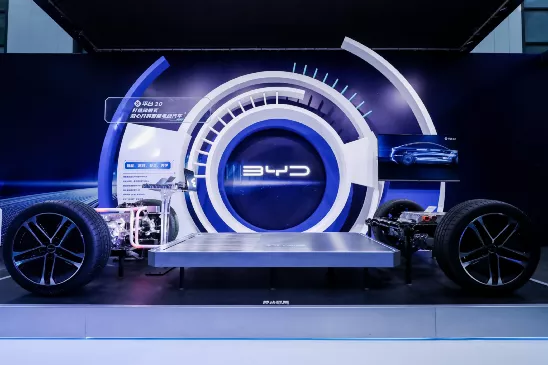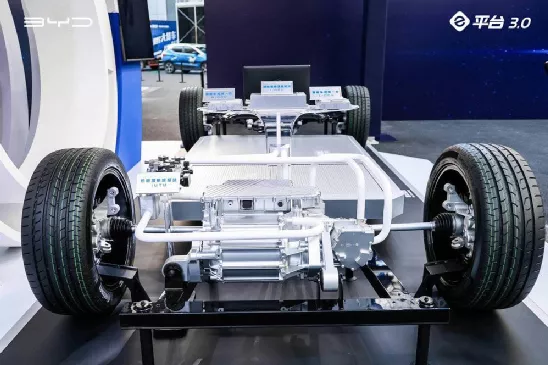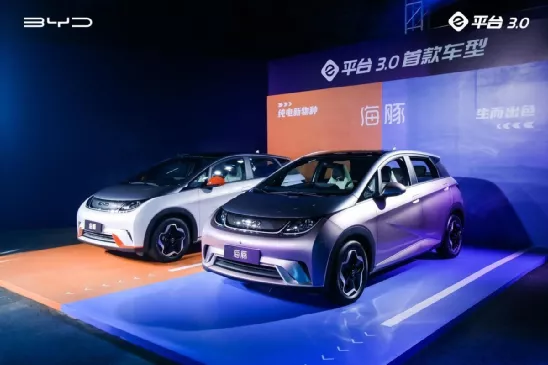The Evolution of Automotive Industry Chain in Outing BaiRen’s Media
Author: Roomy
When “Brave Didi, Don’t Be Scared of Difficulties” flashed on the big screen, one knew that BYD was changing its original way of communication. Although always serious, Wang Chuanfu was saying “Didi” solemnly, which seemed a little awkward, but it indicated BYD’s efforts towards rejuvenation.
This was the launch event of the BYD e-platform 3.0, amid two different voices. BYD’s technical maturity increased, but its grasp of the market and users decreased, requiring adjustments… Different voices mixed together, which seemed contradictory but formed a relatively authentic BYD.

BYD has grasped the way of “being oneself” technically, but still needs to find the mode of “how to be oneself” in the market. Even in the beginning of the launch event, Wang Chuanfu humbly apologized, because “DM-i super hybrid models are still in short supply, and he bowed to every user who had mentioned the car and is still waiting.”
With expanded production lines and three-shift work systems, BYD did its best to deliver the DM-i super hybrid models, which were competitive, thanks to low fuel consumption and high endurance, hitting the pain points of the market. The competitiveness of the DM-i super hybrid models made Wang Chuanfu happy and worried.
Behind the difficulty of finding hybrid cars lies not only the problem of urgent need to solve production capacity but also the fact that, after several waves of public opinion turmoil about blade batteries in the field of electrification, BYD needs to demonstrate its technological prowess in writing the slogan “Safety is the greatest luxury of electric vehicles.”
Of course, Wang Chuanfu has been thinking about this problem. Therefore, after the apology, he explained in simple language why e-platform 3.0 is called the “cradle of the next generation of electric vehicles” in 15 minutes.
Reaching such a high level means that BYD’s mainstream electric vehicles in the next few years will rely mainly on this platform. “If e platform 3.0 succeeds, BYD’s electrification future will have prospects. Otherwise, it will be a crisis.” The industry is not entirely confident about the effect of this platform.
However, the story of the new era of BYD began at the hexagonal building of the Pingshan headquarters.
What is the e-platform 3.0?
“Buy with eyes closed and drive with peace of mind.”
These six words can show Wang Chuanfu’s trust in the e-platform 3.0. As a brand-new electric platform, e platform 3.0 covers body design, three electric systems, operation system, electronic and electrical architecture, and emphasizes safety, intelligence, efficiency, and aesthetics.Since the platform is called “the cradle of the next generation of electric cars”, Wang Chuanfu, who has always insisted on being a tech enthusiast, naturally gave all the good things to the e-platform 3.0. “Great progress has been made, and the Ren Du Er Mai has been unblocked”. This evaluation can be said to be confident.
Of course, this confidence also comes from the blessing of the first two technological platforms.
As we all know, Wang Chuanfu’s ultimate goal for the BYD brand is to create an electric vehicle brand. As early as 2003, BYD proposed the concept of the e-platform; to achieve a breakthrough in the core technology of electric vehicles by using a platform for the key components of the “three electricities.”
The earliest e-platform 1.0 emphasized the platformization of the key components of the three electric systems, consisting of core components such as bidirectional inverter charge-discharge motor controller, high-voltage safety high-energy power battery, and high-power high-speed motor. In 2009, China’s first mass-produced electric passenger car, the BYD E6, was born here.
In 2018, BYD proposed the “33111” modular concept for vehicle key systems, which was the birth of the e-platform 2.0 era. Compared to the 1.0 era, which focused on the core of the three electrical systems, the e-platform 2.0 has gone further.
It emphasized modularization of the key systems of the whole vehicle and applied the “33111” technology, namely the high-voltage three in one, drive three in one, one-plus controller, one smart screen, and one high-performance battery. Among them, the Wangchao series of car models were representative models of the e-platform 2.0 era, and opened an era of electrification for BYD.
Even though BYD has already reached the production of one million new energy passenger cars as of May this year, the long corridors of the press conference were still filled with various consumer doubts about the era of electrification, waiting for BYD’s response.
“What are reliable intelligent electric vehicles?” “Are intelligent auxiliary driving systems assisting people or replacing drivers?” “What should I do if I want to buy a four-wheel drive electric car, but I am worried about the cruising range?” Dozens of meters of corridor cannot express all the bottlenecks in the development path of electric vehicles.
“All of the consumers’ problems are in our hearts; we will find solutions for them.” Wang Chuanfu put his words here, the market is watching, and consumers are waiting. “After every BYD car is developed, I am the first ‘test driver’. I also empathize with the product experience issues and pain points that consumers have.””Integration and innovation centered on user experience, clearing obstacles for pure electric vehicle development” appeared on the big screen behind Wang Chuanfu as he announced the arrival of the e-platform 3.0 era.
From the e-platform 1.0’s achievement of platforming key three-electric technologies, to the e-platform 2.0’s platforming of key systems, to the e-platform 3.0’s platforming of complete vehicle architecture, BYD has experienced 18 years of innovation and iteration.
The new generation of e-platform has achieved battery and body integration, providing full coverage for vehicles ranging from small to large. As expected, once the platform achieves its intended results, relevant technologies and concepts will be fully implemented, and at least three years of development for intelligent electric vehicles will be accelerated.
“e-platform 3.0 is the product of BYD’s integration of knowledge and action for many years, and is the most crucial layout for BYD’s transformation from electrification to intelligentization in the new energy vehicle revolution. This is the cradle of the next generation of electric vehicles,” said Wang Chuanfu, expressing his dream.

Dreams come with the times, but one cannot ignore the fact that model popularity is fleeting and is BYD’s chronic disease. Especially in the Wang Dynasty series, which is the most representative model matrix of BYD new energy vehicles, it sparked a storm in the market since the Qin model, but was soon replaced by the next Wang Dynasty model.
The primary problem to be solved in the e-platform 3.0 era is this issue, and this is also the root of Wang Chuanfu’s attempt to change the style, awkwardly shouting “Brave DiDi, no fear of difficulties.” Wang Chuanfu is too eager to change this current situation by relying on only one or two vehicle models.
So, does the e-platform 3.0, given the responsibility, have the strength to uphold Wang Chuanfu’s grand dream?
The “Customized” Architecture of Blade Batteries
For Wang Chuanfu and BYD, the importance of the new generation pure electric platform is self-evident.
Like in the 1.0 and 2.0 eras, the e-platform 3.0 consists of a front electric drive system, a middle power battery system and a rear electric drive system, supplemented by electric drive control, battery control, cockpit air conditioning system, battery thermal management system, and low-voltage electrical system.
Compared to the previous two generations, the most significant design of the e-platform 3.0 is the integration of blade batteries into the vehicle structure, achieving battery and body integration.
Simply put, the e-platform 3.0 consists of an eight-in-one electric power unit + wide temperature range integrated thermal management + blade batteries + battery and body integrated design + domain control electronic and electrical architecture + software and hardware decoupling BYD OS, achieving complete vehicle architecture platforming.# Introduction
The blade battery is not only an energy system but also a safety component. It is a pure electric exclusive power transmission path created by BYD’s new platform. The company is committed to improving the overall rigidity of the vehicle to the level that traditional fuel vehicles can achieve, as well as effectively addressing user pain points such as safety and low-temperature endurance.

BYD hopes to involve power batteries, which were previously isolated, in the overall safety of the vehicle through its e-platform 3.0. “Let the upper limit of traditional fuel vehicle structural strength become the lower limit of pure electric vehicle,” the company says.
Overall, e-platform 3.0 is more like an architecture “customized” for the blade battery.
BYD’s confidence in integrating battery safety and vehicle safety comes from its persistent use of lithium iron phosphate as the cathode of its battery cell technology over the years. The fact that the company can achieve this is not easy.
In theory, perfection does not necessarily mean that there will be no deviation in executing this safety concept in the event of an actual collision. BYD Han’s highly publicized blade battery collision issues also highlight this point.
However, Han belongs to the era of e-platform 2.0 and does not have the technical strength of e-platform 3.0. The first mass-produced model based on the e-platform 3.0 is the “Dolphin,” a pure electric small car classified as A0, which was released last month. In addition, the first concept car built on the e-platform 3.0, the Ocean-X, has also made its debut, which is said to be the prototype of the second model, the Sea Lion.
These two models will be samples for the market to test whether e-platform 3.0 is mature or not. It will also determine whether e-platform 3.0 can clear the pain points of pure electric vehicles and speed up the development process of intelligent electric vehicles in three years, as BYD’s founder Wang Chuanfu hopes.

Although a range of over 500 kilometers is no longer a technical challenge, the range is still one of the pain points of electric vehicle commercialization. This is why e-platform 3.0 uses an eight-in-one electric power assembly.
Wang Chuanfu hopes that through the e-platform 3.0, combining 800V high-voltage charging, eight-in-one power assembly, intelligent domain control architecture, self-developed operating system BYD OS, and other configurations, the company can achieve the peak of electrification.
How does BYD define the peak of electrification?## Selling a system? Get a car with it!
The reason why e-Platform 3.0 is defined as the cradle of the next generation of electric vehicles and Wang Chuanfu’s bargaining chip lies in its “intelligence.”
“Electrification is only the ‘first half’ of the new energy vehicle revolution, and intelligence is the key battle of the ‘second half.’ Brave Didi, not afraid of difficulties.” Intelligence is the qualification standard set by BYD for the second half of the game.
“The only criterion for judging whether a car is truly intelligent” is whether the in-car infotainment system can fully take over or replace all the functions of a smartphone. Therefore, in terms of intelligence, BYD has developed domain control, developed BYD OS, and achieved decoupling of software and hardware.
BYD has been struggling to catch up in the process of intelligence, and although new energy models are selling well, they have found it difficult to complete the whole-car OTA upgrade. However, in the era of e-Platform 3.0, BYD has become more “aggressive” in its pace.
On this platform, BYD integrated the traditional distributed electronic and electrical architecture into a domain control architecture, divided into four domain controls: intelligent power domain, intelligent vehicle control domain, intelligent cockpit domain, and intelligent driving domain, simplifying and streamlining.
The advent of e-Platform 3.0 means that BYD, which has been at a disadvantage in architecture, has put in extra effort to make up for it. By deeply integrating the driving, braking, and steering functions of the entire vehicle, fully utilizing the characteristics of rapid motor response, BYD has developed the industry’s first power domain controller, which is equipped on the Dolphin model.
BYD takes the same wild approach to doing intelligent systems as it does to making electric cars, “doing everything ourselves.” The self-developed BYD OS system, in addition to effectively implementing advanced automatic driving, can also greatly improve the speed of new feature iteration, shortening the iteration cycle by more than 70%.
With the over-the-air software update and vehicle networking capabilities, automakers are required to comprehensively innovate the electronics and software parts of their vehicles, and reserve a lot of redundant space for future function expansion.
e-Platform 3.0 is also striving to achieve this in its layout.
It integrated hundreds of controllers in the past into one control system, and the electronic controllers and software are transitioning from distributed to centralized, providing possibilities for simplified R&D and production, reducing maintenance difficulty, saving costs, and greatly improving OTA speed.Compared with Xiaoli Wei, BYD’s accumulation in the electronic component industry chain enables it to achieve self-research and controllability faster. Based on BYD OS, BYD’s models can support full-lifecycle FOTA and hardware upgrades.
It can be said that winning the second half of the “intelligentization” war is the ambition that Wang Chuanfu has never hidden.
Therefore, e-platform 3.0 domain controllers reserve multiple hardware expansion interfaces to adapt to the functional adaptation from small cars to large cars. “We can make cars ranging from 100,000 to 400,000 yuan to achieve full coverage from small cars to large cars”. This means that there is more direct competition with the backbone models of traditional luxury car companies.
If the technological concept of e-platform 3.0 is fully realized, it will greatly affect the pace and rhythm of global electric vehicle development.
BYD judges that in order to accelerate the development of electric vehicles, it is necessary to continue to break the traditional division of labor barriers in the industry chain. “BYD will continue to open up and share with the industry, and is expected to accelerate the development process of global smart electric vehicles by at least three years.”
“In 2018, we opened e-platform for sharing, and now Mercedes-Benz, Toyota, Didi, and others are working with BYD.” Wang Chuanfu said, “e-platform 3.0 will continue to open up and share with the industry.”
As a result, there is an evaluation in the industry.
E-platform 3.0 is designed to make BYD a global electric vehicle supplier and DM OEM factory. CATL sells batteries, Infineon sells power electronics, BYD sells batteries and systems, and can also provide you with a car.
This article is a translation by ChatGPT of a Chinese report from 42HOW. If you have any questions about it, please email bd@42how.com.